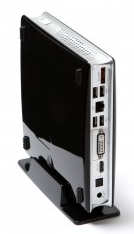Parts of the past two days were spent getting a bare-bones PC assembled, operating, and getting my favorite flavor of Linux installed. Since I’ve been battling a cold virus this week, progress has been good. It’s running bit without network connections!
The Zotac ZboxHD-ND22 is a small-format PC that’s directed at the streaming-media market but it has a 64-bit chip (Intel low-voltate Celeron SU2300), can handle 8GBs of RAM, and has beaucoup connections: USB, eSata, HDMI, DVI, 802.11n wifi, ethernet. I got two Corsair DDR3 4GB RAM sticks along with the Zotac box from one of my favorite online retailers, Newegg. (Most of their stuff whips from Memphis to us here in StarkVegas which usually results in next-day delivery at ordinary prices.) I already had a Western Digital Caviar HD, 7200 RPM, 320 GB sitting in my office closet, purchased before when it was on a ridiculous sale price somewhere.
It would have been nice if the Zotac had a 1394a Firewire port so I could try it with my new Flex 3000 when it’s delivered next week. The Zotac does have a spare Mini-Express PC slot hidden under the motherboard. The Zotac tech support confirmed that any “compliant” Mini-Express PC firewire card should work but there’s no external case outlet for the firewire connector. So, the Dell Studio Quad-Core PC that I’ve used at my office desk is being moved to my ham shack to manage the Flex 3000 SDR. Needless to say, it does have a Firewire port plus 8GBs of RAM, 500GB HD, DVD burner, and many USB and other media ports so it will be mounted beneath the counter behind dual doors. I’ll detail this setup later with pictures once I get this all hooked-up and assembled.
The biggest issue that I had with the Zotac was that the 64-bit version of Linux Mint 10 (“Julia”) would not boot! The 32-bit version did as well as the 64-bit version of Ubuntu’s latest release, 10.10. Hmm, Intel explicitly says that the Celeron SU2300 chip IS a 64-bit CPU. I had not mentioned that this particular Zotac offering (ND22) has the NVIDIA ION GPU on board. It would feed a HD TV but, in my case, it only has to adequately drive my 30″ Dell monitor. What was stopping the Linux Mint 64-bit DVD from booting in the external DVD drive connected via USB? I had searched Zotac’s support forums and found out that I had to disable the HD after putting the DVD as the priority boot device. Nothing seemed to work!
It’s an old story: always check the checksum (MD5) for the downloaded install image! Apparently the Linux Mint mirrors have a bad image for the 64-bit edition of the “standard version” of “Julia”! After verifying this using a free MD5 program on my Macbook Pro, I re-burned the ISO and it booted fine. The installation on the Zotac moved along like a champ but I was unable to get networking up, partly due to the in-process nature of my network setup in my home office (I need to buy a switch for the hardwired connections such as the Zotac.)
Even with probably another day of driver installation, trouble-shooting, and my set of usual package installations, the Zotac is going to be a very useful box. I started with PCs back during the late-1970s with TRS (who remembers that acronym?) computers. But, since the DOS/Windows era, this is the first time that I won’t have a Windows-based PC in my office! I’ll have my Macbook Pro plus the Zotac/Linux Mint. The Windows machine will be relegated to running the Flex SDR transceiver in my ham shack. I’ll report later on the finished product and how it works on a day-to-day basis.
It’s a multi-threaded, 64-bit computer that’s about the size of a Mac Mini in terms of form-factor. We’ll if my Linux distro of choice, Linux Mint, will serve me well in my reading, research, and writing work. Since I may put the Icom 706 on the edge of this table-desk over the Winter, I may see if the Zotac can handle rig control, too!
73s



